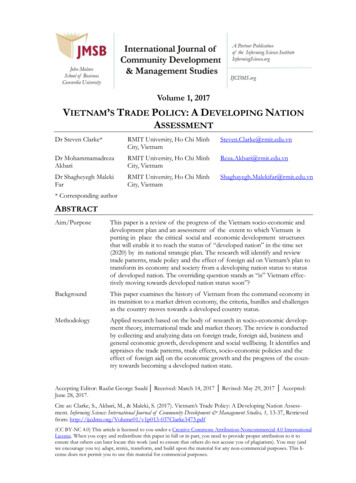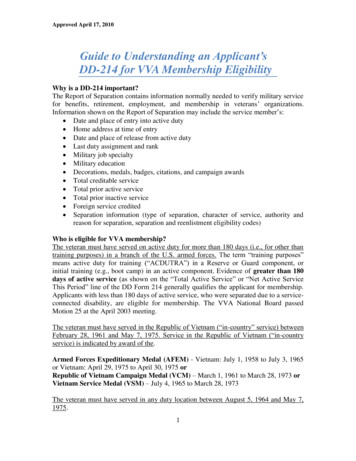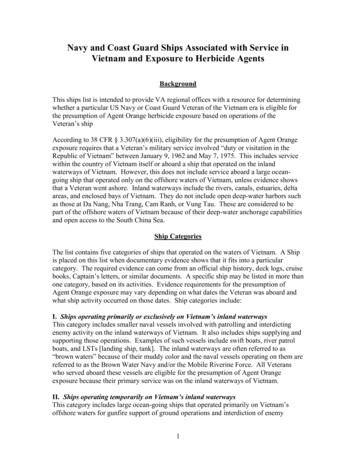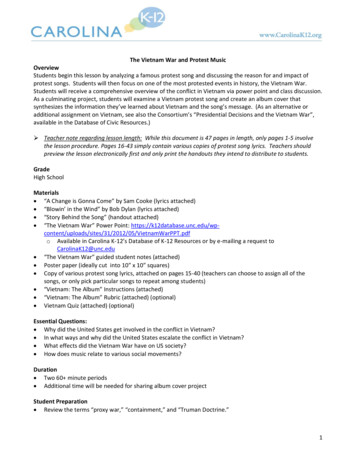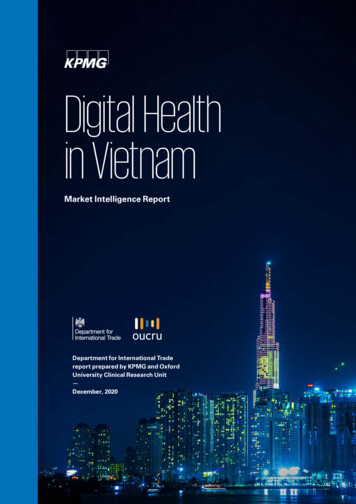
Transcription
Digital Healthin VietnamMarket Intelligence ReportDepartment for International Tradereport prepared by KPMG and OxfordUniversity Clinical Research Unit—December, 2020
Table of Contents040618223236ForewordOverview ofVietnam’s economyDigital healthecosystemKey areas indigital healthDigital healthregulationMacroeconomicindicatorsOverview of digital healthmarket in VietnamHealth informationtechnologyVietnam’s healthcaresector overviewLocal digital healthecosystemsTelehealth / TelemedicineDecision 4888/QD-BYT National agenda fore-health adoptionMarket accessstrategies forUK companiesTelecom Infrastructure:ConnectivityConsumer healthelectronicsAI and Big Data indigital healthOpportunities forUK companiesCyber Security Lawand RegulationBig Data / AI-basedmedical devicesPotential hurdlesfor UK companies:legal perspectives onprocurement process
ForewordWelcome to the Digital health in Vietnam – Market intelligence report!In an age of growing challenges from non-communicable diseases, and emerging threats from infectious diseasessuch as COVID-19, digital health has the potential to offer new solutions and alleviate pressure on overstretchedhealth systems. Digital health technology can empower patients to actively participate in their care, improve clinicaloutcomes and enhance operational efficiency.Innovation and technology have touched many aspects of life in Vietnam and healthcare is no exception. In aconcerted effort to embrace Industry 4.0, the Vietnamese government has committed to a national agenda thatseeks to harness the potential of digital solutions across the health system. This has set a solid foundation for digitaltransformation in Vietnam.Vietnam and the UK share many of the same aspirations. We seek to utilise digital innovation to expand equitableaccess to quality care, in line with United Nations Sustainable Development Goal 3, on good health and wellbeing. Atthe early stage of digital transformation, Vietnam has plenty of opportunities for innovative solutions from the UK. Inthis comprehensive guide, we provide insight into current market opportunities across health informatics technology,telemedicine, AI and Big Data. The report also explores the future direction of digital healthcare transformation inVietnam and potential challenges facing new entrants to the market.The UK and Vietnam have a rich history of collaboration, and this year we celebrate 10 years of strategic partnership. Iam delighted to support UK organisations interested in entering the Vietnamese market and I wish you every successin exploring long-term partnerships in Vietnam that will further strengthen our bilateral healthcare ties.Over the past two decades, Vietnam has achieved laudable improvements in key quality of life metrics suchas life expectancy, infant mortality, and access to affordable medicines. This success is the result of thegovernment’s concerted effort to modernise the health system and expand access to affordable care. At the timeof writing, Vietnam has extended Universal Health Coverage (UHC) to 90% of the population, and targets to reach95% by 2025. This coverage ratio leads its regional peer markets. The country nevertheless still has a relativelyhigh out-of-pocket expense ratio while spending the highest amount of GDP on healthcare. It is therefore likelythat if Vietnam hopes to continue to expand access to quality care and maintain sustainable health financing, thehealth system will need to find a way to provide more services, while expending fewer resources per patient.Digital health is one answer to achieving scale of access while improving clinical outcomes and maintaining costs.To do this, the government needs to expand market access and encourage international business and clinicalpartnerships.UK companies have many of the missing digital pieces Vietnam needs to accelerate progress towards itshealthcare development goals. At the same time, digital health companies that understand Vietnam’s uniquepopulation health challenges and can provide collaborative solutions will gain access to one of Asia’s fastestgrowing healthcare markets. Through this market access, companies can achieve early-entrant advantage andmeaningfully help Vietnam’s financial and physical burden of disease.This document is intended as an introductory guide to Vietnam’s digital health market. Please do not hesitate toreach out to its authors or Department for International Trade as you begin your exploration.Enjoy the readFor more information on these opportunities and how we can help you do business in Vietnam, please reach out toour team.Emily HamblinDepartment for International Trade in VietnamDecember, 2020Luke TreloarManaging Director –KPMG Global Strategy GroupNational Head –Healthcare and Life SciencesVietnam and CambodiaGuy ThwaitesDirectorOxford University ClinicalResearch UnitLouise ThwaitesSenior Clinical Research FellowOxford University ClinicalResearch UnitDu Vu Hoang TuanManagerKPMG Global Strategy GroupVietnam and CambodiaLe Hang NgaAssistantKPMG Global Strategy GroupVietnam and CambodiaContributorsVo Thi Kim NganAssociate DirectorKPMG Global Strategy GroupVietnam and Cambodia4Market Intelligence ReportMarket Intelligence Report5
Overview ofVietnam’s economyMacroeconomic indicatorsPopulationPopulation overviewAt the time of writing, Vietnam hasa population of 96.5 million, makingit the 15th most populous countryin the world, 8 th in Asia and 3rd inSoutheast Asia (behind Indonesia andPhilippines)1. Despite the addition ofaround 1 million people per annum,the rate of Vietnam’s populationgrowth has slowed gradually, fromapproximately 2% per annum in theearly 1990s to around 1.1% throughoutthe 2010s. By 2024, the county’spopulation growth rate is expected toslow to 0.8% per annum, reaching atotal population of 101.1 million2.As Vietnam’s birth-rate declines, itsaverage population age will continueto rise. Currently, Vietnam is enjoyinga so-called “golden structure” in itsage demographics, with 70% of thepopulation aged 15 to 64 years. Thisage structure has been a key driverin the country’s recent economicdevelopment and will continue topush its transition from a largelyagrarian economy to one led byexport manufacturing and domesticconsumption. After 2030, Vietnam willhowever begin to age rapidly, with theover-65 years of age cohort growingat an anticipated 5.3% per annum.This could drive the growth of thecurrent “retirement age” populationdistribution 300% by 2050, potentiallystraining health and related resources.1.World Population Prospects, the 2019 Revision2.Fitch Solutions6Market Intelligence ReportImplications to digital healthIndicatorGoldenpopulationstructureIssueAmong the working-agepopulation, nearly half areunder 34 years of age,which is favourable forthe adoption of innovativescience and technology.AgeingThe golden populationpopulation structure is alsoassociated with an ageingpopulation. The fastergrowth rate of the peopleaged 65 years and abovewill create a burden onhealthcare facilities anddemand for care services.This will be particularlyacute for elderly-care inthe country.ImplicationVietnam is well positioned toadopt digital health solutions.For instance, there will be apotentially large addressablemarket for consumer healthelectronics in the country.The application of Big Dataand AI can bring geriatric caresolutions. Vietnam can applypassive sensors and other nearpatient monitoring technologiesto enable remote care solutionsthat link an individuals’ behaviourto treatment.At the same time, electronichealth records will pave theway for more efficient medicalinformation management.Governments and policymakerscan utilise relevant populationbased data to initiate preventativeprograms and make decisionsat a health-system level.Health workers will be ableto deliver healthcare servicesmore effectively, thanks to theavailability of historical healthrecords and related trainingprograms.The adoption of remotemonitoring and telemedicineof elderly patients will lessenhospital overcrowding by allowingdoctors to monitor patients fromtheir homes, and thus freeinghospital resources such as bedsand saving administrative costs .Economic developmentOver the last several decades,Vietnam has achieved rapideconomic and social development,which has driven the demand formore advanced healthcare services.Beginning in 1986, the Doi Moireforms initiated a broad-basedeconomic transformation, whichopened a largely closed economyto international markets and tradeand began a series of ‘pro-business’reforms. As a result of thesepolicies, Vietnam achieved higheconomic growth rates that liftedthe country to Emerging Marketeconomic status. This strongeconomic expansion will likelycontinue to benefit the country bycreating an attractive growth storythat will further attract ForeignDirect Investment (FDI) (growingby 13.5% per annum from 2014to 2019 in terms of registeredcapital), which in turn will bringmuch needed technology andknowledge transfer 3. Vietnam hassigned 13 Free Trade Agreements(FTAs) further accelerating inboundFDI. Most notably of which arethe ASEAN Free Trade Agreement(AFTA), the Comprehensiveand Progressive Agreement ofTranspacific Partnership (CPTPP),and more recently the EU VietnamFTA (EVFTA). These tradeagreements are lowering tariffson many goods including medicalequipment and will help positionVietnam as an attractive investmentand trade destination. At time ofwriting, Vietnam is in discussionswith the UK on a possible bilateralagreement. Such an agreementwould extend similar market accessbenefits to UK-based organisations.Growth in FDI is driving GDP percapita and the rapid expansion ofan urban middle class. This middleclass is expected to account forup to half of the total populationby 2035 4 and will, according to theWorld Bank, drive growth in percapita healthcare expenditures.This expansion in healthcareexpenditures will be more apparentin higher-end care and in urbanareas, which could expand ruralhealthcare access inequalities.Implications to digital healthIndicatorIncreasedlivingstandardIssueAn increase in livingstandards and healthcareexpenditures will likelyexpand Vietnam’s accessto digital health, whichcan be provided at alower incremental costthan traditional modelsof care.ImplicationSome of the most notableexamples include consumerhealth electronics (e.g. hitech wearables) and telehealth(e.g. remote health diagnostics,monitoring, intervention, andeducation). The applicationof telehealth will play animportant role in supportingthe diagnosis and treatment ofnon-communicable diseasesacross the population. However,this poses a challenge for thelower income groups withless access to technologicaladvances, particularly those inremote, underdeveloped, orrural areas. To attain universalhealth coverage for the entirepopulation, further governmentsupport and policy incentives willbe required.Vietnam’s GDP per capita and real GDP growth from 2017 to 2025fVietnam’s GDP per capita and real GDP growth (2017 to 2025f)5,0004,0003,0006.82,3667.18.27.02,8282,567 02017 2018 2019 2020e 2021f 2022f 2023f 2024f 2025fGDP per capita (USD)9.08.07.06.05.04.03.02.01.00.0GDP Growth, % y-o-yGDP Growth & Healthcare expenditure per capita in 2019GDPGrowth (%)Healthcare expenditureper capita (% of 4.0%Indonesia5.2%3.7%Thailand4.1%3.7%Country3. The Ministry of Planning and Investment4. Fitch SolutionsSource: Fitch SolutionsMarket Intelligence Report7
Vietnam’s healthcare sector overviewHealth status in VietnamHealthcare structure in VietnamThe World Health Organization (WHO) recently estimated that non-communicable diseases now account for 77%of all death and disability in Vietnam. Of these, cardiovascular disease and cancer are the two most commoncontributors to premature death and loss in disability-adjusted life years (DALYs), followed by diabetes/chronic kidneydisease as the 3rd most common cause of death and 4th cause of DALYs. Many of these deaths can be preventedwith improved diagnosis, monitoring, and tech-enabled early-stage interventions.Healthcare systemImplicationTelehealth can promote a healthy lifestyleand encourage preventative measures throughpatient risk-factor monitoring in pre-diseasestages. The utilisation of Big Data and AI indigital health allows for real-time, populationbased, forward-looking data that can help avoidor mitigate non-communicable diseases whileenhancing care delivery.Top causes of death in 2019 & percentage change from 2009 - 2019NATIONAL31%25%45%52%32%28%63%District Health Bureau17,11822,489Lung cancer13,825 es)18,2279,391LRI*Ischemic rrhosisAlzheimer’sdiseasePublicPrivate Centralpreventative healthcentresMedical andpharmaceuticaluniversities and collegesPrivatePublic Provincial general andspecialty hospitals (Class I& II)PublicPrivate Provincialpreventative healthcentresProvincial secondarymedical schoolsPublicPrivatePublic District general hospitals(Class II, III & IV)District Health Bureau is an agency under the DistrictPeople’s Committee, supporting districts’ healthcaremanagement and preparing decisions, directives,plans, etc. across all aspects of the healthcare sectoron the district level.PrivateDistrict preventativehealth centresCommune Health Centre is an agency under theCommune People’s Committee, supporting communes’healthcare management (providing primary health careservices, most basic care and health education).PrivatePublic Commune healthcentresPublicAvailability of public /private sector11,044 14,367DiabetesCentral general andspecialty hospitals (Class I& II) Commune Health Centre107,65938,005Academic institutionsOther ministries including MOD, MOT, MOIT, andMARD run healthcare network of hospitals and clinicsDepartment of Health is an agency under theProvincial People’s Committee, supporting provincialhealthcare management and preparing decisions,PROVINCIAL directives, plans, etc. across all aspects of the(63 provinces) healthcare sector on the provincial level.30%86,130Other ministriesDepartment of Health(645 districts)18% TERTIARYMOH is a government al agency responsible fornational management and regulation development,management of national hospitals, research andPasteur institutes, universities and colleges.DISTRICT% change from 2009-2019Health centresMinistry of Health (MOH)SECONDARYIssueThe nature of ill health in Vietnam ischanging from communicable to noncommunicable diseases. This trend isexpected to continue, which will create agreater need for long-term and coordinatedhealthcare services that cater to chronicdiseases. Digital health is well-positioned tohelp address these challenges.HospitalsAdministration LevelsImplications to digital healthIndicatorNCD impact onhealthHEALTHCAREINSTITUTIONSPRIMARYThere is increasing recognition of the important interactions between non-communicable diseases co-existing withinfectious diseases, particularly cardiovascular diseases. For example, hepatitis C Virus infection is associated withan increased risk of cardiovascular disease and represents a global burden of the loss of 1.5 million DALYs. Thistragic burden falls disproportionately on low-income and middle-income countries. Risk of type 2 diabetes mellitusis increased by almost 70% in Hepatitis-C infected patients. Similarly, in people living with HIV, increased risk ofcardiovascular disease has been noted. Whilst there is limited data on co-existing cardiovascular and infectiousdiseases in Vietnam, the high rates of both means that improving diagnosis and management of these is likely to havea particularly significant impact in Vietnam.ORGANISATIONAL STRUCTURE OFHEALTHCARE SYSTEMPrivateNon-availability of public /private sectorSource: The Ministry of Health, World Health OrganizationSource: World Health Organization8Market Intelligence ReportMarket Intelligence Report9
Hospital capacityHospital numbersHealthcare professionalsVietnam’s public sector has a decentralised hospital system classified into four groupscorresponding to four administrative levels. At the central level, specialised and generalhospitals provide secondary and tertiary care, and are active in research, and function asteaching hospitals. At the provincial or city level, hospitals and medical centres mostly providesecondary and tertiary care, combined with outpatient services. Each province is dividedinto roughly 20 districts. District health centres offer primary and some secondary careservices. Finally, at the communal level, Communal Health Centres (CHCs) offer primary andpreventative health services. Communal healthcare centres are generally the first point ofcontact for much of the population, especially in rural areas.Vietnam ranks on the lower end of countries with regards to trained HealthcarePractitioners (HCPs) per capita. This shortage is particularly acute inspecialised care, such as cancer, palliative care, geriatrics, and mental health.The distribution of health workers between urban and remote areas is also achallenge, with higher concentrations in urban areas.The Vietnamese private healthcare sector has started to play an important role as a provider ofcare in major cities. The percentage of private hospitals is projected to increase rapidly in thecoming years as domestic corporations develop hospital groups and clinic chains across thecountry. Some of the examples include Hoan My Medical Corporation, and Vinmec HospitalNetwork of Vingroup. Main drivers behind growth are:01Many public hospitals lack needed infrastructure investment;02Rising personal income allows patients to increase out-of-pocket payments forprivate sector and/or premium healthcare services and16520131,06316520141,0711692015Public 6810Nurses per 1,000 of total populationSource: Fitch SolutionsCAGR’13-19Total hospital numbers1.3%Public hospitals1.2%Private hospitals1.6%2018Private hospitalsHospital bedsOver the past five years, according to Fitch Solutions and the General Statistics Office ofVietnam, approximately 6,000 hospital beds per annum have been added to the healthcaresystem, corresponding to a CAGR of 2.5% (from 2013 to 2018). Of these additional hospital beds,nearly 16% are at national level, while 43% and 41% are added to provincial and district levels,respectively. This demonstrates the effort of the government in alleviating the overloaded capacityof hospitals across Vietnam.However, the proportion of private hospital beds remains low (5%), mainly due to the marginalvolume of private hospitals. Nevertheless, the government has indicated its intent to grow theratio of private hospital beds to 20% of total hospital beds through public and private partnerships.In terms of the number of hospital beds per capita, there are large regional variations. Morespecifically, Vietnam’s North Central and Central Highlands have far fewer hospital beds per capitacompared to other regions. Recently, the shortage of hospital beds has increased: bed to patientoccupancy rates has reached 120-160% in some public hospitals. This increase is often mostpronounced in central hospitals in major cities.Market Intelligence Report0.821.341.25Vietnam6.382.6Physicians per 1,000 of total populationSource: Fitch Solutions, World Health Organization, General Statistics Office of Vietnam100.47Thailand0Number of hospitals in Vietnam (2013-2018)1,0692.12UKMalaysiaFDI encouragement policies allows foreign investors to build whollyforeign-owned hospitals.03When compared with regional peer markets, one can see Vietnam’s shortagesare particularly acute in trained nurses. As of 2018, there are 77,995 physiciansand 128,386 nurses in the country, which is relatively low compared to thetotal population (around 1 physician and 1.3 nurses per 1,000 lstaffingIssueCongested andovercrowdedhospitals remain achallenging issuein Vietnam. Thisstrains resourcesin central andprovincialhospitalsand createsinefficiencies atthe district andcommunity levels.ImplicationDigital health can help address capacityconstraints faced by public hospitals Byintroducing solutions such as telehealthand electronic health records, morepatients, even in rural settings, cangain access to needed healthcare, thusalso improving hospital efficiency andreducing patient crowds. From a healtheconomics viewpoint, telehealth andelectronic health records can also helphealthcare providers cut cost by reducingpaperwork, improving safety, eliminatingduplicative tests, and improving healthoutcomes. The latter drives economicbenefit by lowering readmittancethrough long-term remote monitoring.AI and wearable tech have the potentialto improve quality of care while reducingcost of care in Vietnam. By extendingpatient access to AI-enabled wearabledevices, healthcare professionalscan gain a real-time view of patientconditions and make more accurate andfaster diagnoses. Layering AI and BigData into the monitoring and diagnosisprocess will give clinicians the abilityto analyse multiple patient data setssimultaneously to identify irregularitiesand take early-stage preventative actionwhen interventions are more effectiveand cheaper.Market Intelligence Report11
Healthcare insurance system in VietnamHealthcare quality and accessVietnam has made great strides in expanding health insurance coverage. After introducing compulsory insurance in2015, Vietnam now aims to grow the coverage rate of health insurance, setting the goal of reaching 95% in 2025.Nevertheless, out-of-pocket expense ratios in Vietnam are some of the highest in ASEAN, which puts considerablefinancial pressure on lower income households.It should be noted however, Vietnam has made substantial progress in lowering out-of-pocket expense from 61% in1999 to 45% as of 2019.Healthcare 411.711.812.251.5%50.2%48.5%2014Private .5%4.3%Patient journeyMedical tourismInpatient and outpatient careInbound medical tourismIn Vietnam, outpatient visits outpace inpatientadmissions by two orders of magnitude. Overall, bothinpatient admissions and outpatient visits remainedconsistent from 2014 to 2019, with 5,600,000 casesadmitted to hospitals and approximately 156,000,000outpatient visits served per year respectively7.Overcrowding remains prevalent, given the fact thatMedical tourism has flourished globally over the pastdecades and is now valued at over USD53 billion. Thisvalue is expected to grow at 12.9% through 2025 8.Asia Pacific is a top source of, and destination for,medical tourism patients. This, however, is still in theearly stages in Vietnam. While competitively priced, thenumber of foreign patients in Vietnam is still relativelysmall compared to Singapore, Thailand, and Malaysia.Most of Vietnam’s inbound medical tourists come fromLaos and Cambodia. For now, Vietnam is not consideredas a top destination for medical treatment due to a lackof health infrastructure investment and regional brandrecognition.hospitals often run inpatient care at overcapacity levels, meaning more than onepatient is assigned to the same hospitalbed, andhealthcare facilities will often see between5,000-8,500 outpatients visit per day,particularly at central hospitals.Public (USDbn)Source: Fitch Solutions, World Health Organization, General Statistics Office of VietnamPublic healthcare insurancePerson working in the agriculture,forestry, aquaculture and saltindustry; household members88% PopulationCoverage (2018)Children under age six, near poor individuals,and studentsVietnam’s efforts to reduce the average inpatient stayshave not yet seen success. Average stays remain at orabove a week since 2013. While this is comparable tolevels seen in the Philippines and Indonesia, Singapore,Malaysia and Thailand have managed to shorten thisindicator to less than 5 days. For patients, a lengthierstay means higher costs and risk of nosocomial(“healthcare-acquired”) infections from other patientsat the hospital. At the same time, for hospitals, higherlength of stay results in lower patient capacities.National Assembly Representative, People’s Council member,preschool teachers, social welfare groups, dependents of police andarmed forces staff1992199820052008201801strict regulations imposed for non-life insurancecompanies operating in the market;02high insurance premiums compared to publicoptions; and03low brand awareness of private insurancepackages.5. News articles6. Fitch Solutions12Market Intelligence ReportCritical factors for why patients prefer overseastreatment to local care can include,qualifications and experience offoreign doctors,2% PopulationCoverage (1992)availability of medicines, andbetter service and overall quality of care.Private healthcare insuranceIn 2018, 33 million people (35% of total population)were covered by some forms of private healthinsurance. This coverage, however, only represents 2%of total health expenditures5. Low coverage rates arelargely due toAs the local healthcare sector continues to experiencecapacity constraints, a significant number of uppermiddle to high income patients have chosen to receivehealthcare services abroad from regional countries suchas Singapore, Thailand, Malaysia, or even further afieldin the United States. The total amount paid for theseservices abroad is estimated to be USD2 billion yearly 9.reputation of foreign facilities,Employees in non-state enterprises with more than 1employee, other organisations, war veterans, and the poorCivil servants, employees in state enterprises, employee in private enterprises withmore than 10 employees, pensioners, and people on subsistence for the elderlyOutbound medical tourismHowever, after the increase in healthcare fees atlarge public hospitals brought about by the so-called‘autonomy mechanism’, more people are expected tojoin private health insurance policies to gain access tohigher reimbursement rates and more comprehensivecoverage. Furthermore, continued growth in privatesector employment will likely expand employee-benefitinsurance packages as a share of total private insurance.Compared to peer market countries, insurancepenetration rates (calculated by total premium over totalGDP) for Vietnam remains on the low range, accountingfor only 2.4% of total GDP in 2018. This indicatesroom for further growth6. According to the InsuranceAssociation of Vietnam, the insurance penetration rateis expected to reach 3-4% in the near term.As well, inconsistency in diagnosis between localhealthcare facilities can also play a role in the decisionof patients to seek second opinions abroad.7.Fitch Solutions8. KPMG Analysis, PR Newswire9.KPMG Analysis, PR NewswireMarket Intelligence Report13
Implications to digital healthSmart phones21.731.6%27.0CAGR (19-24)29.628.6Smart phone sales value (USD billion)2.4%15.120142015CAGR (14-19)201720182019CAGR 84.03.82017201820193.420162024Key observationsOverall, the market of smart phones has experienced rapid growth over the past five years (nearly 32% per annum),and is on track to reaching a saturated status in the next five years. While growth is expected to slow down, thedemand for new products will continue to drive the market.Mobile-cellular telephone subscriptionsMobile-cellular subscriptions (million)3G and 4G subscriptions (million)2.3%141.5CAGR (19-24)126.2-1.0%130.4CAGR (14-19)120.0Vietnam possesses many of the necessaryqualities needed to develop inbound medicaltourism, such as highly skilled professionals,yet the industry remains in its early days.Vietnam has rapidly developed its privatehospital networks, some of which achievedinternational standards such as JointCommission International (JCI) accreditation.Nevertheless, building trust with patients willtake more time.The adoption of digital health will helpaccelerate the development of patient trustby increasing transparency and convergingdomestic care standards with the bestinternational practices.CAGR (14-19)128.8Medical tourismEven though Vietnam’s total number ofhospital beds and ratio of doctors per capitahave reached national objective levels,hospital capacity is still overcrowded. Thisindicates that availability of professionals andfacilities still does not meet the country’sneeds.Smart phone sales volume (million)123.9Patient journeyImplicationIncreasing demand for ageing infrastructure andhuman resource shortages are driving hospitalexecutives and government officials to leveragedigital to optimise the patient experience andcreate a health system without walls.Digital health technology and the medicaltourism industry are converging to enhancepatient experience and trust in the process. Thiseffort will shrink the perceived quality of caredifference between Vietnam and other markets,which will help to stem the USD2bn in outboundmedical tourism and strengthen Vietnam’s brandas a medical tourism destination.Digital tools are increasing patient engagementthrough direct patient-provider communication,instant messaging apps, telemedicine, andencrypted electronic records. AI-enabledtechnologies are just a few examples of digitalintegration in the medical tourism supply chain.Telemedicine over online video calls in pretreatment diagnosis and assessment and posttreatment can be beneficial in that it lessensthe strain on physical medical infrastructure andempowers patients to have consultations on aschedule and location of their choosing.Bringing patient consultations into a digitalsetting can improve clinical outcomes andlower costs for Vietnamese patients. Clinicianswill have access to powerful new tools tolongitudi
capita healthcare expenditures. This expansion in healthcare expenditures will be more apparent in higher-end care and in urban areas, which could expand rural healthcare access inequalities. Implications to digital health Vietnam's GDP per capita and real GDP growth from 2017 to 2025f Vietnam's GDP per capita and real GDP growth (2017 to .
